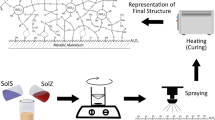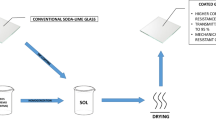Abstract
This paper describes the preparation and characterization of glass films consisting of SiO2, Li2O, Na2O, K2O or MgO in varying compositions on stainless steel and aluminum substrates by sol–gel method. Silver phosphate or silver incorporated zeolite was also introduced into the sols for obtaining antibacterial effect. The SiO2/Li2O/Na2O system having the composition of 85:5:10 wt% was found as the optimum for obtaining a stable sol and film formation. The films were investigated by scanning electron microscopy (SEM) and electron dispersive analysis by X-ray (EDX), Fourier transformed infrared (FTIR) spectroscopy, thermo-gravimetric analysis (TGA) and differential thermal analysis (DTA). Homogenous films having 300 ± 20 nm thicknesses were formed by spin coating and then by curing at 500 °C for 1 h. Obtained films had high adherence to the metal substrates and they were also durable in acidic, basic or NaCl environments. They also presented a powerful antibacterial effect against E. coli.






Similar content being viewed by others
References
Lo KH, Shek CH, Lai JKL (2009) Recent developments in stainless steels. Mat Sci Eng R 65:39–104
Gümpel P, Arlt N, Telegdi J, Schiller D, Moos O (2006) Microbiological influence on the electro-chemical potential of stainless steel. Mater Corros 57:715–723
Baena MI, Marquez MC, Matres V, Botella J, Ventosa A (2006) Bactericidal activity of copper and niobium-alloyed austenitic stainless steel. Curr Microbiol 53:491–495
De Damborenea JJ, Cristóbal AB, Arenas MA, López V, Conde A (2007) Selective dissolution of austenite in AISI 304 stainless steel by bacterial activity. Mater Lett 61:821–823
Sreekumari KR, Nandakumar K, Takao K, Kikuchi Y (2003) Silver containing stainless steel as a new outlook to abate bacterial adhesion and microbiologically influenced corrosion. ISIJ Int 43:1799–2806
Zhao Q, Liu Y, Wang C, Wang S, Peng N, Jeynes C (2008) Reduction of bacterial adhesion on ion-implanted stainless steel surfaces. Med Eng Phys 30:341–349
Yu B, Davis EM, Hodges RS (2008) Surface nanocrystallization of stainless steel for reduced biofilm adherence. Nanotechnology 19:335101.1–335101.8
Bambauer R, Mestres P, Pirrung KJ (1994) Scanning electron-microscopic investigation of catheters for blood access. Artif Organs 18:272–275
Sioshansi P (1994) New processes for surface-treatment of catheters. Artif Organs 18:266–271
Meinert K, Uerpmann C, Matschullat J (1998) Corrosion and leaching of silver doped ceramic IBAD coatings on SS 316L under simulated physiological conditions. Surf Coat Technol 104:58–65
Akhavan O, Ghaderi E (2009) Bactericidal effects of Ag nanoparticles immobilized on surface of SiO2 thin film with high concentration. Curr Appl Phys 9:13811385
Husheng J, Wensheng H, Liqiao W, Bingshe X, Xuguang L (2008) The structures and antibacterial properties of nano-SiO2 supported silver/zinc-silver materials. Dent Mater 24:244–249
Jansen JC, Kascchiev D, Erdem-Senatalar A (1994) In: Jansen JC, Stöcker M, Karge HG, Weitkamp J (eds) Advanced zeolite science and applications, studies in surface science and catalysis, vol. 85. Elsevier, Amsterdam
Jeong YM, Lee JK, Ha SC, Kim SH (2009) Fabrication of cobalt-organic composite thin film via plasma-enhanced chemical vapor deposition for antibacterial applications. Thin Solid Films 517:2855–2858
Li B, Liu X, Meng F, Chang J, Ding C (2009) Preparation and antibacterial properties of plasma sprayed nano-titania/silver coatings. Mater Chem Phys 118:99–104
Kupfer H, Richter F, Friedrich S, Spies HJ (1995) Deposition and properties of tin/carbon multilayers for corrosion protection of steel. Surf Coat Technol 74–75:333–338
Radin S, Ducheyne P (2007) Controlled release of vancomycin from thin sol–gel films on titanium alloy fracture plate material. Biomater 28:1721–1729
Burunkaya E, Kesmez O, Kiraz N, Camurlu HE, Asilturk M, Arpac E (2010) Sn4+ or Ce3+ doped TiO2 photocatalytic nanometric films on antireflective nano-SiO2 coated glass. Mater Chem Phys 120:272–276
Schmidt H (1994) Multifunctional inorganic-organic composite sol–gel coatings for glass surfaces. J Non-Cryst Solids 178:302–312
Dislich H (1986) Sol–Gel—science, processes and products. J Non Cryst Solids 80:115–121
Burunkaya E, Kiraz N, Kesmez O, Camurlu HE, Asilturk M, Arpac E (2010) Preparation of aluminum-doped zinc oxide (AZO) nano particles by hydrothermal synthesis. J Sol–Gel Sci Technol. doi: 10.1007/s10971-010-2229-2
Brinker CJ, Scherer GW (1985) Sol–gel-glass 1 gelation and gel structure. J Non-Cryst Solids 70:301–322
Pavon J, Jimenez-Pique E, Anglada M, Lopez-Esteban S, Saiz E, Tomsia AP (2006) Stress–corrosion cracking by indentation techniques of a glass coating on Ti6Al4V for biomedical applications. J Eur Ceram Soc 26:1159–1169
Mennig M, Jonschker G, Schmidt H (1998) Verfahren zum versehen einer metallischen oberflache mit einer glasartigen schicht. German Patent No: DE197 14 949 A 1
New Test Method for Optical Imaging Evaluation of Adhesion by Tape Test Specimens, ASTM D 3359 WK97
Nelson DL, Cox MM (2004) In: Freeman WH (ed) Lehninger principles of biochemistry
Kiruthika P, Subasri R, Jyothirmayi A, Sarvani K, Hebalkar NY (2010) Effect of plasma surface treatment on mechanical and corrosion protection properties of UV-curable sol–gel based GPTS-ZrO2 coatings on mild steel. Surf Coat Technol 204:1270–1276
Mendez-Vivar J, Mendoza-Bandala A (2000) Spectroscopic study on the early stages of the polymerization of hybrid TEOS-RSi (OR’)3 sols. J Non-Cryst Solids 261:127–136
Vinogradova E, Estrada M, Moreno A (2006) Colloidal aggregation phenomena: spatial structuring of TEOS-derived silica aerogels. J Colloid Interface Sci 298:209–212
Mahajan AM, Patil LS, Bange JP, Gautam DK (2004) Growth of SiO2 films by TEOS-PECVD system for microelectronics applications. Surf Coat Technol 183:295–300
Zhang X, Wu Y, He S, Yang D (2007) Structural characterization of sol–gel composites using TEOS/MEMO as precursors. Surf Coat Technol 201:6051–6058
Chang-Wei L, Zhong H, Tong-Geng X, Yun-Xian C, Lan L (1999) TG-DTA-MS and DSC studies on the thermal-treatment process of the 20% AlO3/2-SiO2-epoxySiO3/2 organic ± inorganic hybrid system. Thermochim Acta 334:149–155
Xu H, Navrotsky A, Nyman M, Nenoff TM (2004) Crystal chemistry and energetics of pharmacosiderite-related microporous phases in the K2O–Cs2O–SiO2–TiO2–H2O system. Microporous Mesoporous Mater 72:209–218
Dey SK, Zuleeg R (1990) Processing and parameters of sol–gel PZT thin-films for GaAs memory applications. Ferroelectrics 112:309–319
Arslan O, Arpac E, Sayılkan H (2010) Siliconcarbide embedded hybrid nanocomposites as abrasion resistant coating. J Inorg Organomet Polym 20:284–292
Standard test method for determining the activity of incorporated antimicrobial agents in polymeric or hydrophobic materials, ASTM E 2180-01
Tatar P, Kiraz N, Asiltürk M, Sayılkan F, Sayılkan H, Arpaç E (2007) Antibacterial thin films on glass substrate by sol–gel process. J Inorg Organomet Polym 17:525–533
Hairong L, Chen Q, Song L, Ye R, Lu J, Li H (2008) Ag-doped antibacterial porous materials with slow release of silver ions. J Non Cryst Solids 354:1314–1317
Acknowledgment
Authors would like to thank Akdeniz University Research Fund for financial support. Technical and financial support of NANOen and Mattek is gratefully acknowledged.
Author information
Authors and Affiliations
Corresponding author
Rights and permissions
About this article
Cite this article
Kiraz, N., Kesmez, Ö., Burunkaya, E. et al. Antibacterial glass films prepared on metal surfaces by sol–gel method. J Sol-Gel Sci Technol 56, 227–235 (2010). https://doi.org/10.1007/s10971-010-2298-2
Received:
Accepted:
Published:
Issue Date:
DOI: https://doi.org/10.1007/s10971-010-2298-2




